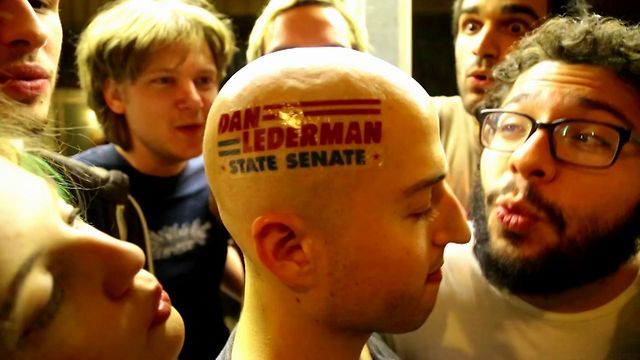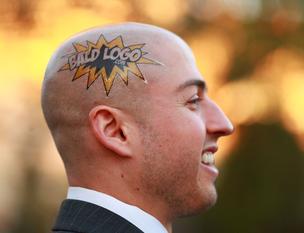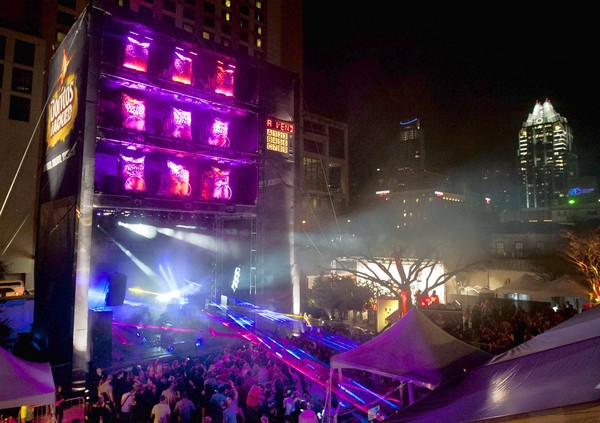
Image Credit: Magic Spoon Production's Vimeo
Few things will make a body more aware of its need of personal space than being in Austin during SXSW. At the height of the music festival, sixth street is a throbbing mass of bodies; most are hurting from the night before; many are pierced and tattooed; and all are in search of further sensory stimulation. Prominence and/or density of bodies are signal features of large scale cultural gatherings like SXSW. Consequently, advertising at these sorts of events often becomes embodied in visually arresting and sometimes ethically questionable ways. This post examines two advertising schemes that came to my attention this SXSW, and thinks about the stakes--rhetorical and otherwise--of confusing bodies with commercial products.
When I was looking around online last week for information about free SXSW shows I noticed that one of the kick-off parties was sponsored by a company called Bald Logo. The name sounded funny so I did some investigating. It turns out the founder Brandon Chicotsky is an Austin resident (pictured above) who sells ad space on his bald head. To rent Chicotsky's scalp, or the scalp of one of his promoters dubbed the "Baldangelicals," it costs $320/day. Apparently, these guys walk around the "highest density foot traffic areas of the city" promoting whatever brand they've temporarily stamped on their heads.
The company calls what they do "animate social marketing," which highlights the fact that these bald guys are moving targets. But the word 'animate' also strikes me as a trivializing and evasive way of describing the medium that distinguishes this kind of advertising from more stable and/or conventional forms: the human body. In addition to being animate bodies are feeling, thinking, profoundly individual, and a million other things. So, a more honest tagline for Bald Logo might read, "social marketing with human bodies." But somehow that sounds a touch too exploitative.

Image Credit: www.bizjournals.com
Bald Logo's business concept raises a lot of questions, not the least of which is why SXSW has attracted similar schemes for monetizing human bodies in the past. Recall the Homeless Hotspots controversy of SXSW 2012 which involved paying homeless people to wear Wi-Fi transmitters in busy parts of town. Whether hawked by bald guys or homeless people, company brands and their services are just millimeters away from surgically attaching themselves to human bodies. This might be a scary thought for some, but perhaps not for the thousands of people lining up to wear a computer called Glass on their faces.
You might say that Bald Logo is intentionally gimmicky, so gimmicky that it should not be taken seriously. But it is through gag humor that the company openly normalizes the sale of human bodies (witness their slogan "purchase ad space on a bald head"). And how could seeing ads on people's heads possibly not degrade our notion of personhood? When someone is called a blockhead, or an airhead, or methhead (significantly, I can't come up with any positive head terms) the idea conveyed by the noun prefix subsumes the whole person, not just the head. So the question is, who wants to be an adhead?

Image Credit: prweb.com
Bald guys, apparently. But I'll stop picking on them for a minute. There are other advertising spectacles worthy of note like the monstrosity pictured above, which was at SXSW this year and last. It's an official SXSW stage made to look like a giant Doritos vending machine. So instead of advertising that enters or becomes incorporate with the body (like the Bald Logo decals) we have a humongous ad with real bodies inside of it.
As much as I'm uncomfortable with the corporatization of SXSW I have to hand it to whoever was behind the heavy-handed metaphorics of this stage. They basically created a giant monument to consumerism, replete with an audience that feeds on the corporate-sponsored music (and the bodies making this music) as they would toxic-colored, manufactured chips. But the people at the Doritos stage were either oblivious to these implications or perfectly okay with them. For those who are somewhat more mindful of how bodies are being used for commercial purposes, keep your eyes open at the next SXSW. The examples are everywhere.
Comments
It's all been done before
The reason that it won't probably work is that it has already been tried and presented before by an advertising creative director in Canada (who even presented the idea to a guy named "Chicotsky") back in 2009.
Meaning, in many advertising and corporate circles, it's already OLD news.
If it didn't have corporate clients lining up then when it was a REALLY fresh idea, why would it now?